The Miracle of Fort Worth

BY THE TIME longevity expert Dan Buettner arrived at the buttoned-down boardroom of the Fort Worth Club in downtown Fort Worth, Texas, in early 2014, the city was suffering the same problems as most major American cities—and then some. Cowtown, U.S.A. (current population pushing 900,000), had earned its nickname by being a stockyard stronghold in the late 1800s, but now its residents just loved beef, often in large portions. Among the top city officials and businessmen who joined him, not everyone appeared all that healthy.
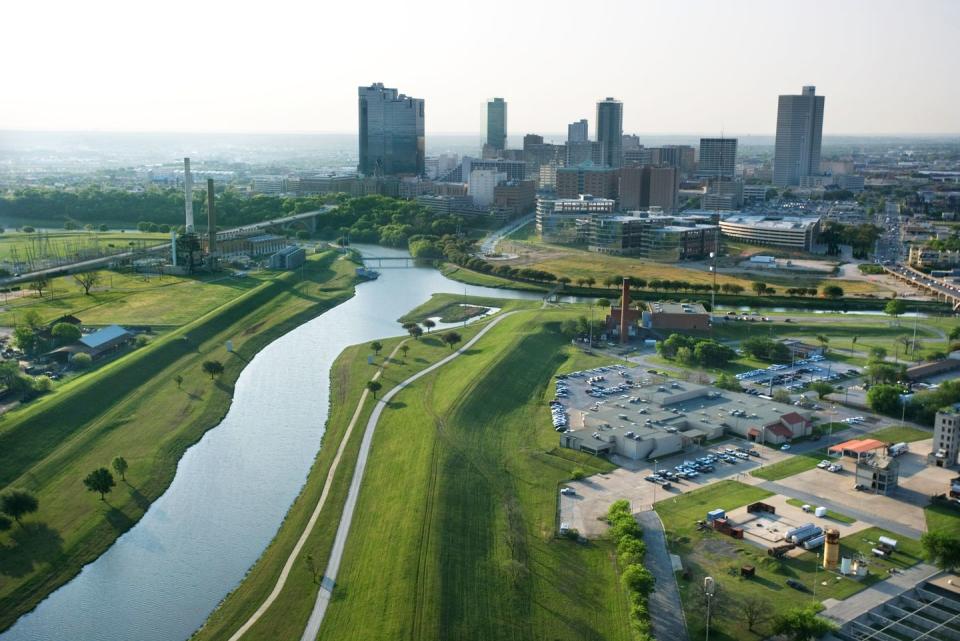
Fort Worth had other problems, too. The Alliance for Biking & Walking ranked it dead last among the country’s 52 most populous cities for commuter walking and biking—and even then one in five people killed in traffic accidents was a pedestrian. The body mass index of its residents beat the national averages, with 65 percent of people overweight and 32 percent of that group qualifying as obese. Residents still smoked in restaurants and even parks, which ranked near the bottom third of the Trust for Public Land’s “ParkScore” list.
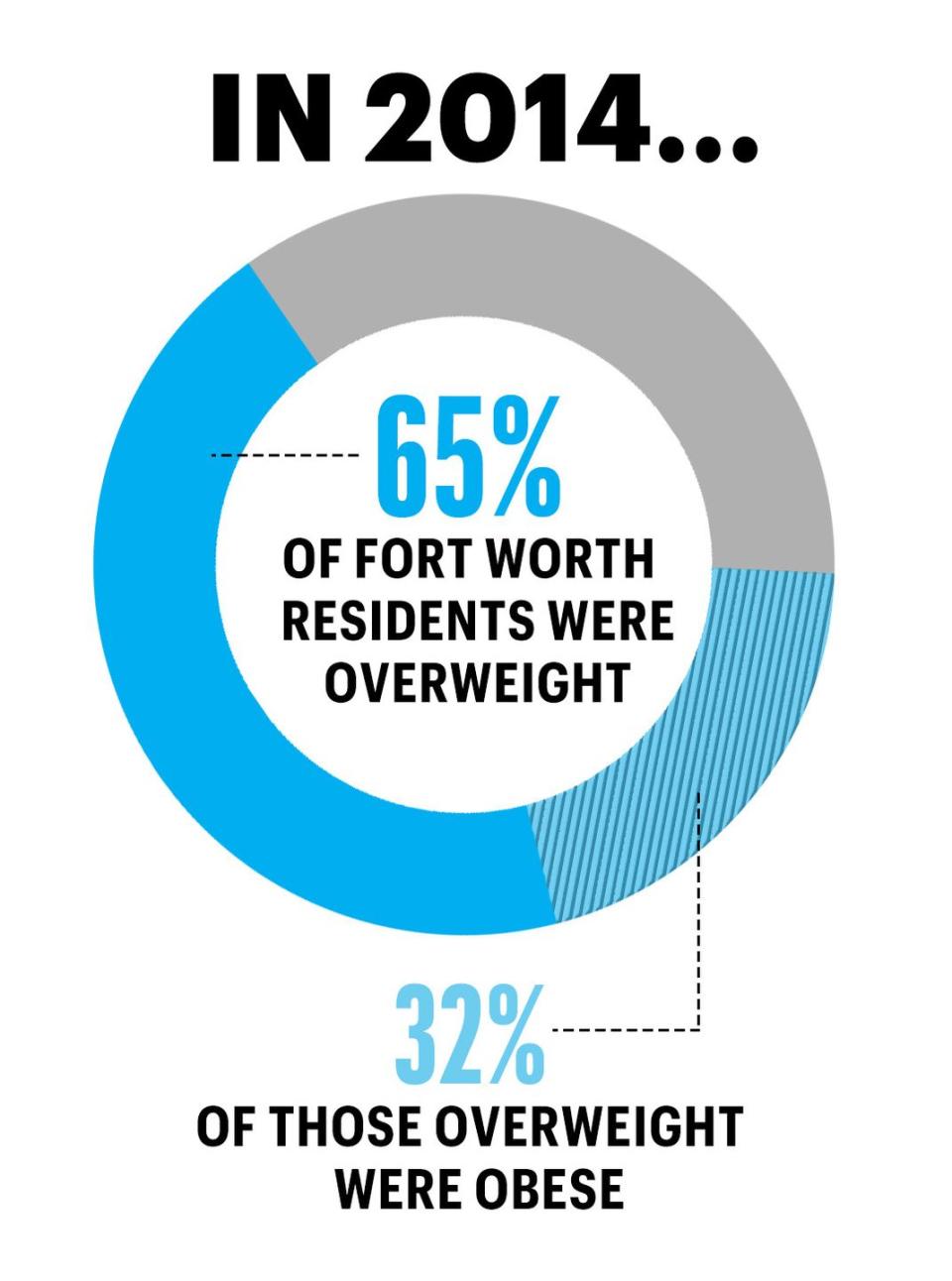
As he stood to address the audience, Buettner, who was then in his mid-50s, looked lean and radiated energy. He’s known as the founder of Blue Zones, a research-project-turned-consultancy-group that, over the past several decades, has been backed by the National Geographic Society and the National Institute on Aging to trace the lifestyle habits in places where people live the longest. Buettner formulated the Power 9, a set of principles to live by for those of us who want to hit old age in stride. He markets them with cheeky code words around their values, like exercise (Move Naturally), outlook (Purpose, Downshift), eating wisely (80% Rule, Plant Slant, Wine at 5), and connecting (Right Tribe, Loved Ones First, Belong).
Buettner told the group that there was a way to “make the healthy choice the easy choice.” But in order to achieve that, the city would need to completely reimagine how its policies, grocery stores, companies, and schools might work together to help change people’s daily routines.
While Buettner spoke, Barclay Berdan, the CEO of Texas Health Resources, a large nonprofit health-care provider in North Texas, remembers watching the group grow increasingly restless. “We had some folks raise their hands and say, ‘I’m not going to quit eating red meat,’ ” he says. People in his own organization wondered why THR might want to take this on. “Because if [people] actually get healthier, they won’t need hospitals.”
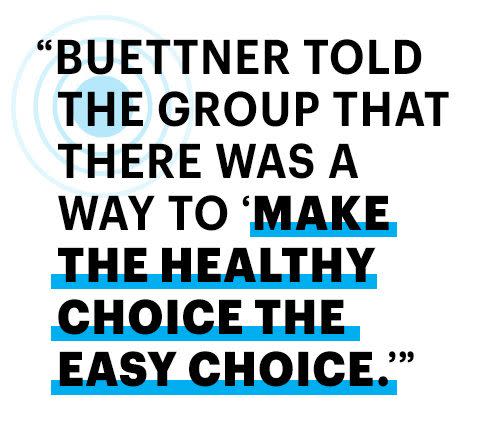
As resistance swelled, so did Buettner’s sense of urgency: Fort Worth had the potential to prove that his theory of wellness could help people on a grand scale, to prove that a major city could transform and buck the modern obesity trend. But the city’s sense of rugged independence ran deep. Exasperated, he finally closed his laptop. “You guys are not ready for this,” he remembers saying. “You should just keep doing what you’re doing.”
It drove home the insanity of saying no: Who wouldn’t want not just a longer life but a better life? Except that Dan Buettner’s most ambitious project appeared to be dying right in front of him.
MORE THAN a decade ago, with his book The Blue Zones—a study of five places where people live longest—a New York Times best seller, Dan Buettner found himself making the rounds on television talk shows. “The greenrooms were full of fad-diet or fad-workout authors,” he recalls. He found this frustrating, having just spent a good chunk of National Geographic Society money trying to construct a scientifically backed theory of wellness.
Buettner wanted to dig deeper. He wondered if there were unhealthy places in the world that had been transformed. He discovered one compelling case abroad: In 1972, North Karelia, a rural region in eastern Finland, had the highest heart-attack rate in the world. The country tasked Pekka Puska, M.D., Ph.D., an intrepid health researcher, with improving people’s health. But the traditional health-education and weight-loss challenges failed.
Karelians were still frying their cheese in butter. So Dr. Puska tapped scientists to cultivate a new variety of canola oil that would grow regionally. His team convinced dairy farmers to plant berries; Karelians wouldn’t give up sausage, so they asked local sausage makers to reduce fat by mixing in a mushroom filler. The key lesson, for Buettner, was that it’s hard to change people’s behavior. Instead, you “change the defaults.” Targeting the entire population a little works better than heavily targeting the most at-risk.

All this tracked with his research on Blue Zones like Okinawa, Japan; and Sardinia, Italy. (The others are Nicoya, Costa Rica; Ikaria, Greece; and Loma Linda, California.) “Nobody’s pumping weights or gobbling supplements or jumping on the latest keto diet there,” Buettner says. “They’re just living their lives.”

It just so happens that these lives play out in places where it’s easier to eat vegetables, fruit, and fish and where walking makes more sense than driving a car. In the right kind of culture, people don’t have to think much about making the right choices. They’re simply living them. When it comes to longevity, it’s environment, vastly more than genes, that determines outcomes. A famous study of Danish twins estimated genetics contribute about 25 percent to factors of longevity. “One of the regulators of the epigenome is a set of genes that sense the environment and then turn on the right genes at the right times,” says David Sinclair, Ph.D., a Harvard University genetics professor. In other words, healthy environments might activate more Blue Zones genes.
Buettner wondered if he could engineer his own Blue Zone. In 2009, he convinced the city of Albert Lea in Minnesota to give it a try. His approach was simple: Make changes to people’s surroundings. Offer a “menu” of some 30 evidence-based policy initiatives. Hit people where they spend most of their time, like at work or school. And make it all voluntary. “As soon as you start telling people what to do, they say, ‘You’re treading on our freedom,’ ” he says.
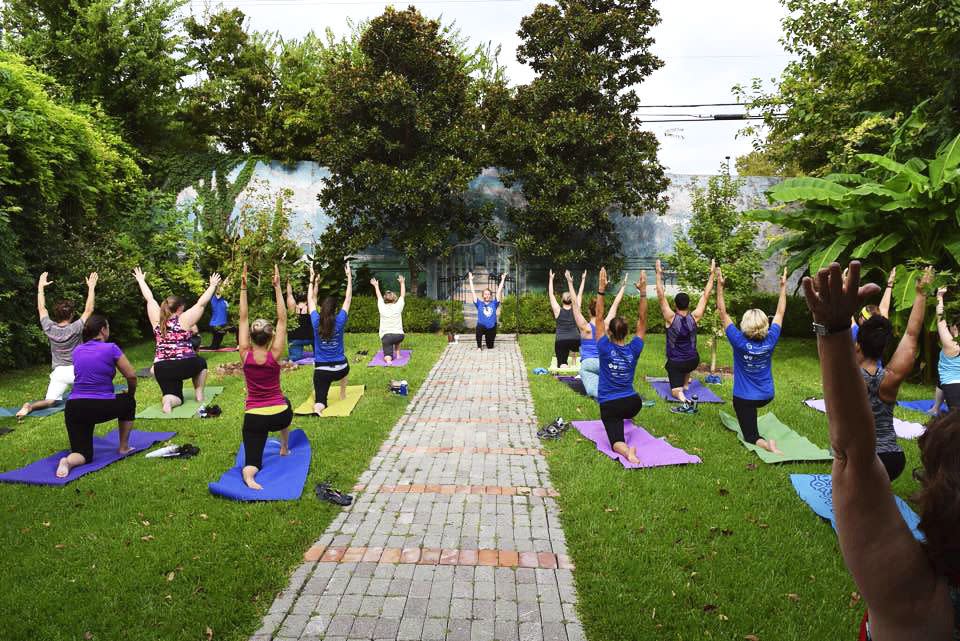
The five-year program was a success. Residents lost weight and saw an uptick in life expectancy; health improvements among city and school employees, meanwhile, resulted in reduced health-care costs. Soon Buettner was getting requests from other places. He’d found a second act that jibed with his own lessons about building a stronger community and having purpose. There was just no proof that any of it could be transformative on a larger scale.
BUETTNER HAD walked into the Fort Worth Club on a long shot: His Blue Zones CEO, Ben Leedle, had once run Healthways, a company that helped employers lower health-insurance costs through wellness programs. They both dreamed of far greater change, so Leedle worked his connection with Texas Health Resources—a former client—to get everyone into the room for the pitch.
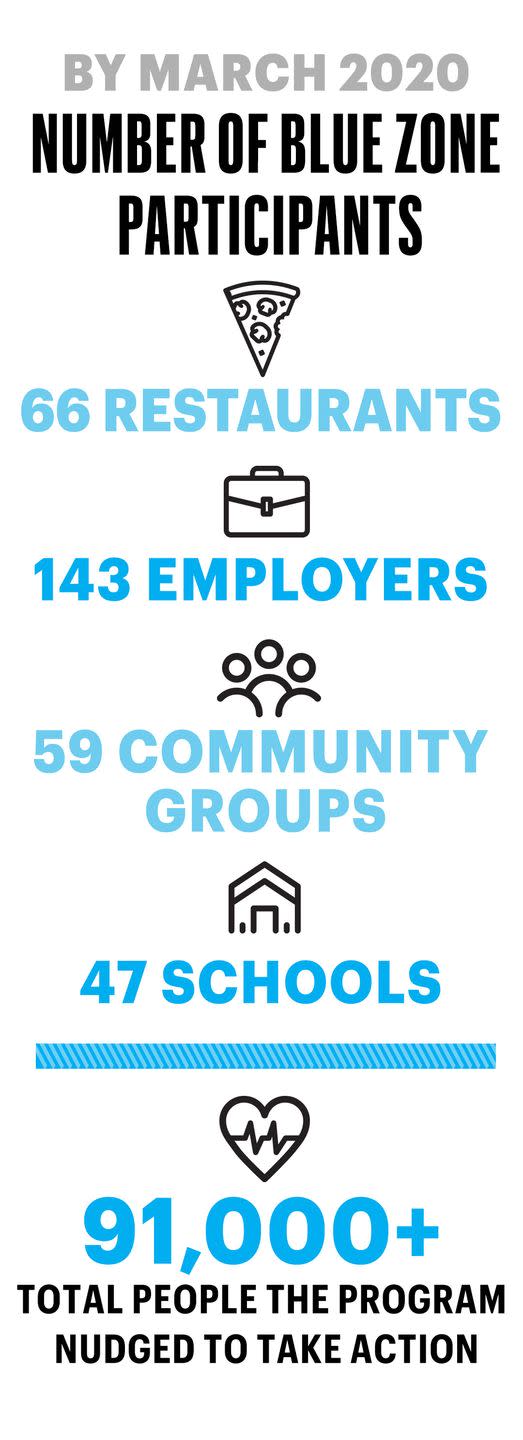
Buettner came armed with some data that got their attention. Gallup had crunched the numbers and ranked Fort Worth near the bottom—185th out of 191 metro areas—on the Gallup Community Well-Being Index, a national survey that asks residents to rate factors essential to overall well-being: purpose, social, financial, community, and physical. Give him five years, he said, and if you don’t see improvement on those metrics, he’d refund a fair amount of his consulting fee. (Although he won’t disclose what he makes per city, it’s obviously substantial.)
Mayor Betsy Price, who at age 70 is still a platinum blonde and favors leopard-spot high heels with her power suits, broke the silence in the room. “I think we ought to give Dan a chance,” she said. After months of planning, the project kicked off in February 2015 with Mayor Price, Berdan at Texas Health, and Bill Thornton, the president of the Fort Worth Chamber of Commerce, leading the charge. They hired 30 full-time Blue Zones staffers, many with existing ties to community groups, and recruited hundreds of volunteers to serve on committees meant to reimagine how people “live, work, play, or pray.”
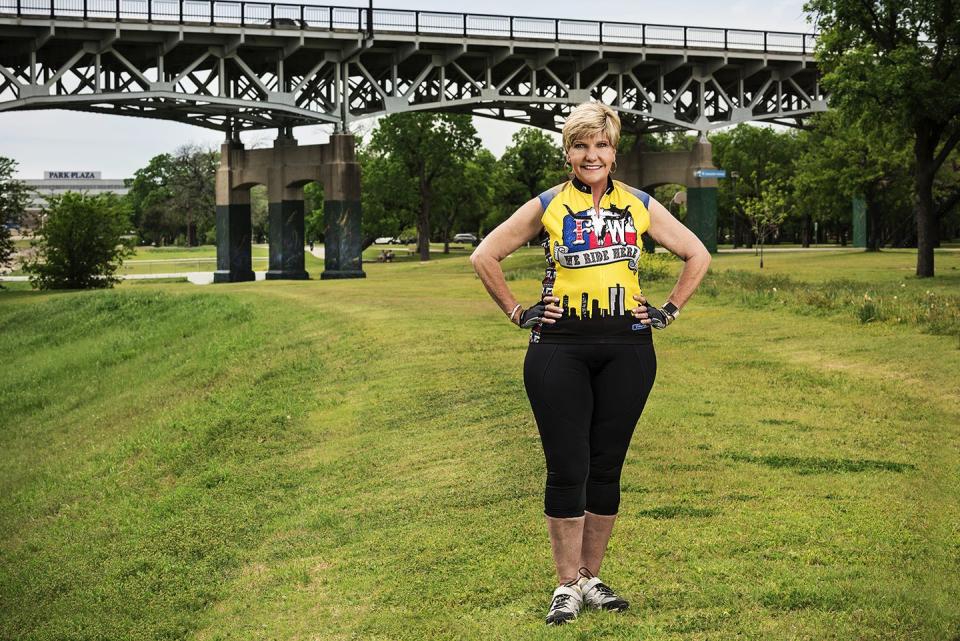
Several major companies agreed to help fund the effort. The key, Price says, was not to make the program appear to be some top-down limitation of people’s choices. “We would just make gentle nudges,” she says, in a nod to the theory of libertarian paternalism espoused by Cass Sunstein, J.D., and Richard Thaler, Ph.D., in their influential book Nudge, the gist of which might be: Get people to make better choices without restricting their freedom. Buettner’s biggest gamble was that he didn’t need to reach everyone all at once to make change happen. He planned to recruit just 15 percent of the city’s population to nudge things in a better direction.
When I arrived in Fort Worth this past February to see how things were panning out, I had the sense, early on, of this sort of subtle manipulation. I parked in a designated Blue Zones spot intended to encourage walking. It didn’t change the fact that I’d just traveled down a ten-lane highway lined with neon signs advertising the dual promise of things like car wash . . . tacos!—the car-centric and sedentary ideology a Blue Zones Project city has to beat. What Fort Worth appeared to need most was a shift in its food, exercise, and public spirit.
EATING A LITTLE LESS and adding more vegetables to your diet sounds easy. But I was barely into the chips and salsa at Los Vaqueros, a popular Tex-Mex restaurant in Fort Worth’s historic Stockyards neighborhood, when I realized that I was going to have trouble abiding by one of the pillars of Blue Zones’ research: Hara hachi bu, an Okinawan principle to eat only to 80 percent satiety.
Los Vaqueros is a Fort Worth institution, and it often does several thousand meals a night. In August 2015, co-owner Vicki Cisneros debuted the new Blue Zones menu, with only about 5 percent of the items specially marked. Gaining Blue Zones certification involves making a number of nudge-like changes, such as: “Do not offer soda, chocolate milk, or fruit juices as default beverages for children’s meals” and “Offer half-size portions of top-selling entrees,” to support customers trying to have a lower caloric intake.
At Los Vaqueros, soft drinks were removed from the children’s menu. Salt and pepper shakers were taken off the tables. It started serving one-egg omelets for brunch, and a plate-sharing charge was dropped. Cisneros still laughs about how people reacted.
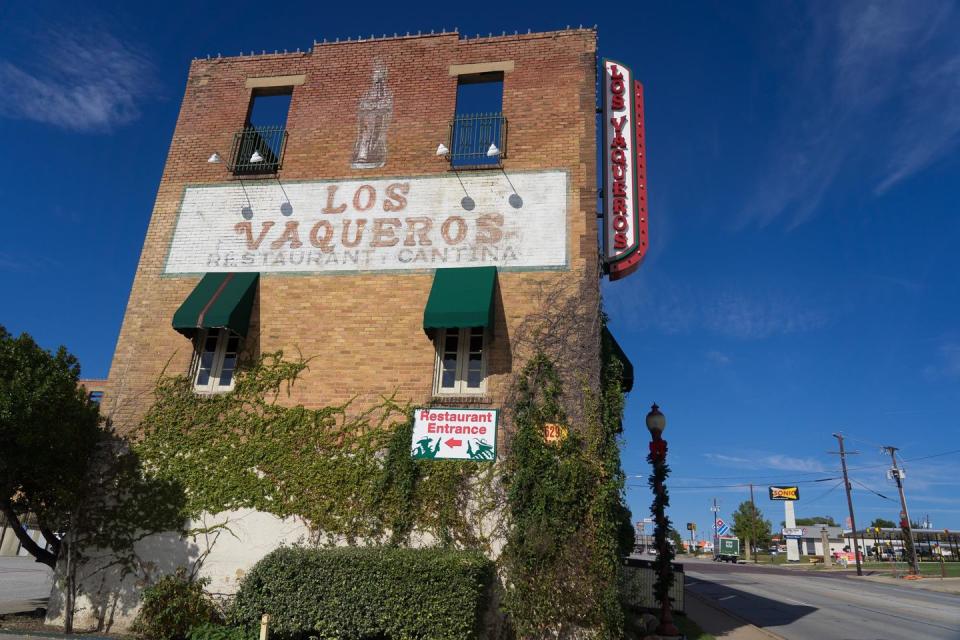
On the day of the new-menu launch, a crew of large men came in and sat down to order, but the hostess forgot to give them anything other than the Blue Zones breakfast menu. Rather than question it, they all got fruit and smaller omelets. The sales of Blue Zones items increased over the first year and have kept climbing.
One of the classic nudge approaches is to change the way food is presented—put the healthy stuff up front, make the less healthy stuff harder to reach. As the project has expanded, many businesses have gotten onboard with that. In late 2017, Darin McBryde, the district general manager of Canteen, a national vending-machine company, worked with Blue Zones and Lockheed Martin—a major area employer—to put healthier options at eye level and adjust prices so sparkling water was cheaper than sugary sodas. Sales of healthier options doubled in blue-collar locations.
Tinkering with vending machines hardly seems the stuff of social change. But Buettner says it’s the little things that matter. “So as people mindlessly move through their day, they make incrementally better decisions,” he says. “When you add those all up during the day, they make a difference.”
I found these small changes scattered over Fort Worth—less a silver bullet, as Buettner told me, than “silver buckshot.” At Central Market, a grocery chain, Blue Zones signs peeped from displays of healthy ingredients and even Sardinian wine. A Blue Zones checkout lane featured smart grab-and-go snacks, especially at kid height.
Stuart Lane, the store’s director of perishables, walked me through the aisles. “I was one of those can’t-eat-a-meal-without-an-animal-on-the-plate kind of guys,” he told me. But today he’s looking more trim.“I switched to a vegetarian diet and stuck with it. It’s changed my life for the better, and so I do nothing but talk about it.”
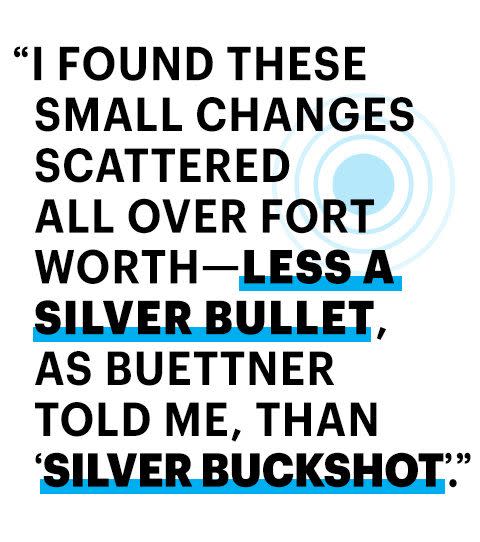
Central Market started making changes in 2015, and the effort spread to an entire chain of local Albertsons stores. That doesn’t solve the issue of neighborhoods where these chains don’t have stores. But in 2018, Sam Moulegiet, who owns RameyMarket, a bodega in the historically impoverished Stop Six neighborhood, decided to start carrying fresh fruits and vegetables after being approached by the Blue ZonesProject team, which was trying to find healthier after-school snacks for kids.
Neighborhood high school art students painted a mural with images of fresh fruit on the side of his building, and locals now walk there for lettuce, bell peppers, carrots, and onions. At the same time, BlueZones sponsored healthy-cooking demos around the city—eventually drawing more than 16,000 participants.
Many of these people also backed BlueZones–proposed changes to city ordinances, so mobile vendors could sell fresh fruit and not just chips and candy, and urban farmers might be able to grow and sell more food inside city limits. The demand for healthier options was there, even if, halfway through the project, they were not always readily accessible.
STAYING ACTIVE also sounds easy. But when Roxanne Martinez, a mother and neighborhood activist, attended her son’s youth football practices in the Diamond Hill neighborhood in the fall of 2016, she saw many parents lounging in camp chairs. She encouraged everyone to sign a Blue Zones pledge to walk together each Wednesday. “I was surprised by the number of parents who got up out of their chairs,” she says. “And it just grew from there.” Once they started connecting more, some people began running together on other days; some joined fitness boot camps.
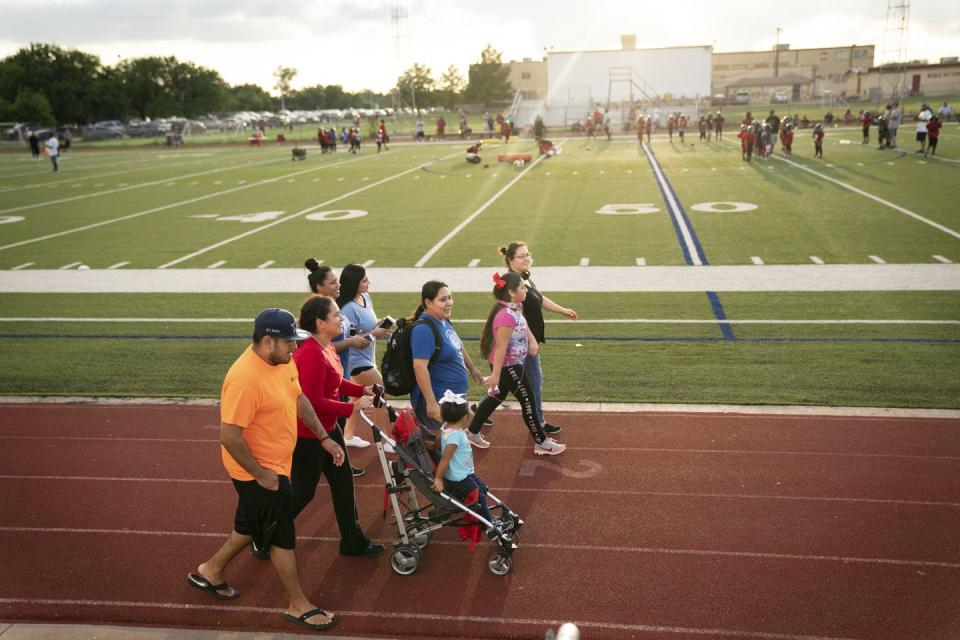
In late 2017, she convinced the local youth sports association to adopt the idea and share it with its teams. A year later, she persuaded a community center to do the same thing. When I met Martinez there, we watched a group of older residents holding their daily moai, a sort of walking support group that’s a staple of life among older Okinawans.
It’s one of numerous moais that have sprung up in Fort Worth—Blue Zones says some 1,500 people eventually signed up—and includes both aging women with Fitbits tucked into their sneakers and older men who still favor flannels and broad-brimmed cowboy hats. Some moais encourage the elderly and parents to walk kids to school for a win-win.
Personal transformations take time, but they’re happening. At Mother Parkers, a tea and coffee company, for instance, workers were encouraged to stretch together before shifts, have standing meetings, and use those designated Blue Zones parking spots. Michael Edwards, a former Division I basketball player, eventually shed nearly 30 pounds of postcollege weight. “It’s all a mind-set,” he says in a promotional videoBlue Zones released in 2019. “Honestly, I feel a lot better. I wake up in the morning ready to go. I feel like a person who has purpose in life.” At city hall, the mayor now holds walking meetings, and one city employee has lost more than 100 pounds.
The Blue Zones wave rolled out slowly: In 2015, only 14 work sites participated. A year later, once Blue Zones had negotiated how to add healthier food and exercise into schools, whole school districts started joining, with students introducing the ideas to their parents. The number of companies participating then quadrupled. By 2018, close to 60,000 people had signed the Blue Zones pledge (which exhorts that adopting a dog may help you stay active). And there have been more changes made around town, even if big hurdles are clearly still ahead.
The city has continually improved its Trinity Trail system—when I met the may-or there, her cowboy-booted security detail shouted, “Bike!” with each passing cyclist—but it still doesn’t have a great overall walk-ability score. Outside the Applied LearningAcademy, a Blue Zones Project–approved school, I was shown a marked crosswalk that had been revamped so that the running club could use an adjacent park for running. Before that, a teacher told me,“we were playing Frogger.” But the crosswalk stretched across what was essentially a high-speed six-lane highway. It still seemed pretty Frogger.
FORT WORTH isn’t going to transform into a Sardinian village where people walk across fields to sip wine and eat bitter greens with their octogenarian friends. But if you nudge people in enough new ways, the momentum can be surprising.
After the Ramey Market got a face-lift, it became clear that nearby residents would walk to get fresh food. Then Blue Zones–affiliated community advocates encouraged the city to convert Bunche Park—an unused plot of land nearby—into another spot to relax, complete with a playground, picnic tables, and walking trails.
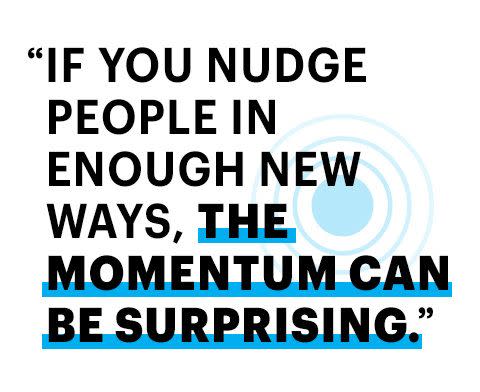
In Diamond Hill, Martinez and her troop of active parents started thinking about how to help the rest of the community. That included being part of a pilot program that brought a mobile fruit cart to practices and games, something they could do because it was now legal. They introduced the program to the high school football team, and, in 2018, the team just so happened to snap a 77-game losing streak. A year later, it won its first district game in more than a decade.
The most obvious sign of new progress is Opal’s Farm, a furrowed five-acre field that runs along the eastern bank of the Trinity River and is surrounded by several major highways. It’s named for Opal Lee, a celebrated local community activist in her 90s, who recognized that the nearby United Riverside neighborhood was not only a food desert but that people would happily work to change that.
Situated on previously unused Water District land, the farm grows everything from green beans to watermelons. “I’m still pulling turnips,” said Gregory Joel, the burly, gray-haired farm manager, on the day I visited. Last year, the farm produced more than 4,500 pounds of food, part of which is donated to food banks while the majority gets sold at farmers markets (where more Blue Zones converts tend to gather) and at a reduced cost in nearby neighborhoods (where people need it the most).
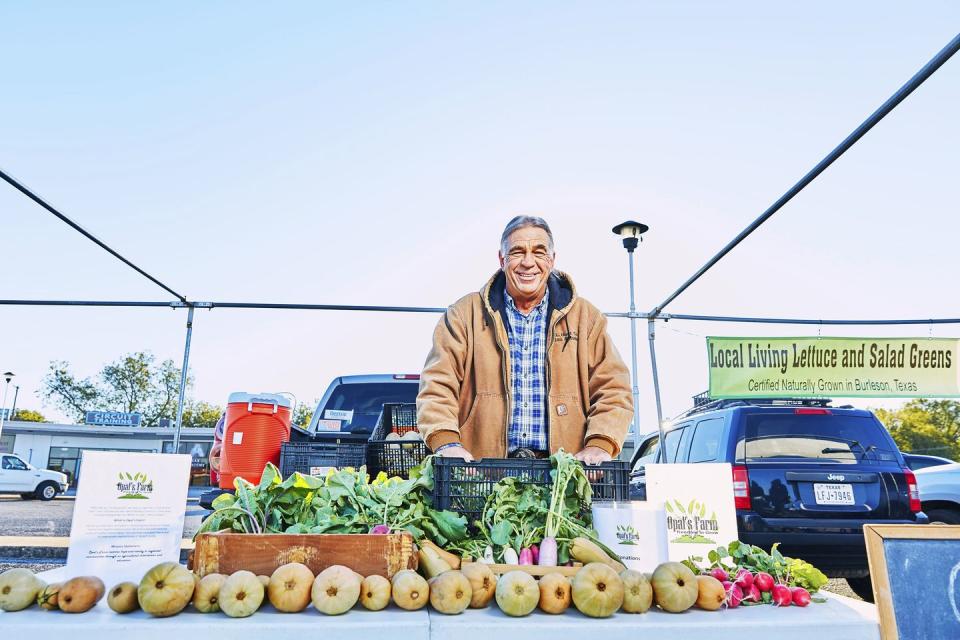
This year, the farm expects to quadruple its harvest thanks to new grants for seed, compost, and supplies that the Blue Zones team helped secure. But it’s also given volunteers of all ages an outlet for activity and a larger sense of purpose—things that align with Power 9 mantras like Right Tribe and Belong.
Fort Worth finally passed a strong smoking ordinance that goes much further than other cities’ and covers vaping. But people are thinking bigger now. Concepts like “Vision Zero”—eliminating traffic fatalities—and implementing “active transportation plans” to reduce car use were once political nonstarters but now have gained traction. “We’re having conversations we never could have had before about health and wellness,” says Matt Dufrene, a vice president at Texas Health. As of this past March, a total of 143 employers, 47 schools, 66 restaurants, 20 groceries, and 59 neighborhood or community groups in Fort Worth are Blue Zones participants. The Blue Zones team estimates it has nudged more than 91,000 people.
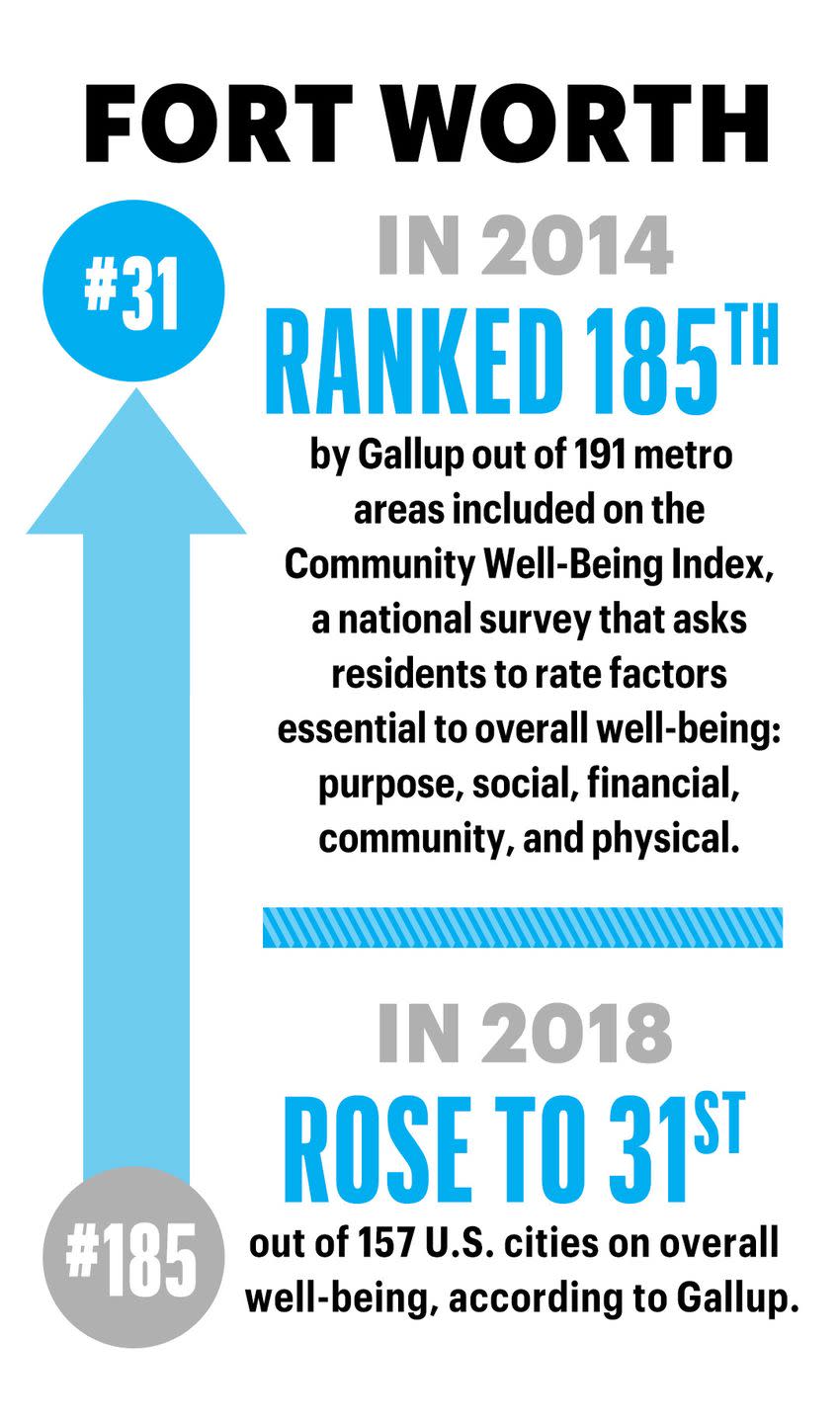
From its near-bottom position on the Gallup index, in 2018 Fort Worth’s scores placed it at 31 out of 157 U.S. cities. The Gallup result was striking for several reasons. The rest of the U.S. was trending downward in well-being during this time. And some of the biggest improvements came in geographic sectors like East Southeast, which includes neighborhoods like Stop Six, previously shown to have the greatest disparities in well-being.
For every dollar Fort Worth spent on these programs, Blue Zones estimates the city gained five back in measures like reduced health-care claims and increased productivity. (For proprietary reasons, Buettner declined to give exact figures.) No other well-being initiative of its size “guarantees the return,” says Leedle.
Next up, Buettner is thinking even bigger: He’s trying to Blue Zone the entire state of Hawaii. (Native Hawaiians, in particular, have high rates of obesity, diabetes, and asthma, and increasing concerns about access to mental-health care.) Buettner is nearly 60 but figures he has plenty of time to keep pushing. Wherever you’re living, he hopes one day you’ll feel the same way, too.
You Might Also Like

